The basic input output system--BIOS--is one of the most important parts of the computer.
It contains important start-up settings that allow the motherboard to communicate with the processor, RAM and hard drive.
Because of this, some people password protect their Panasonic CF-28, preventing anyone from entering the Panasonic's BIOS set-up and making changes without the appropriate password. However, issues arise when the user forgets the password or buys a Panasonic CF-28 with a set password. Unlike some laptops, the BIOS battery on the Panasonic CF-28 is integrated into the motherboard, so you cannot remove the BIOS battery to reset the system.
- The basic input output system--BIOS--is one of the most important parts of the computer.
- Unlike some laptops, the BIOS battery on the Panasonic CF-28 is integrated into the motherboard, so you cannot remove the BIOS battery to reset the system.
Unplug the AC power cord from the laptop socket, as you want to prevent short circuiting. Take out the battery too, and allow the machine to sit for at least an hour. You want all the power to discharge from the machine, and the only way to do that is by removing all power sources. Hopefully this lack of power will reset the BIOS to its default settings when power is returned.
Reinstall the battery and connect the AC Adapter then press the"Power" button to start the laptop. When you see the logo, press the appropriate "F" key to enter the BIOS set-up. Check the black screen prompt on your computer before it enters windows for the appropriate "F" key. The prompt will says something like "Press F2 to enter Setup." Most computers use "F2" but some use "F12," "F1" or the "Del" key depending on the make and model of the computer. If the computer timed out and did not allow you to press the appropriate function key at the right moment, you need to restart the system.
- Reinstall the battery and connect the AC Adapter then press the"Power" button to start the laptop.
- When you see the logo, press the appropriate "F" key to enter the BIOS set-up.
Check the BIOS set-up for password protection. If it again asks for the password, you need to follow the next section to unlock BIOS password.
Restart the computer and press the BIOS Setup "F" key to enter. Look at the computer start-up black screen to see what the appropriate "F" key is. This prompt comes immediately on start-up before the computer enters Windows and will say something like "Press F2 to enter BIOS." On most computers it is "F2" but can also be "F12", "F1" or the "Del" key. Tap this key continuously on start-up until the BIOS screen appears. If you see the Windows logo, you have waited too long to tap the appropriate "Fn" key and will need to restart the computer and do it again.
- Restart the computer and press the BIOS Setup "F" key to enter.
- Tap this key continuously on start-up until the BIOS screen appears.
Write down the BIOS manufacturer and version. Look for these at the top of the BIOS window. The BIOS unlocking software will need the BIOS manufacturer name. Exit the set-up and login to the Windows again.
Download and install BIOS Password eliminating software like PC CMOS Cleaner, CmosPwd or AMI BIOS decoder. Save it at an easily accessible place like the Desktop. Install the program by double clicking the downloaded file and following the on-screen directions to complete the installation. Open the application either double clicking from the desktop Icon or from the "Start" and Programs menu.
- Download and install BIOS Password eliminating software like PC CMOS Cleaner, CmosPwd or AMI BIOS decoder.
- Install the program by double clicking the downloaded file and following the on-screen directions to complete the installation.
Enter the BIOS manufacturer name when asked for it by the application. Expect the program to give you possible password options for your BIOS make. Write down all the possible password options and restart the computer.
Enter the BIOS set-up by pressing the appropriate "F" key displayed on the black start-up screen when you turn your computer on. This will usually be the "F2" key, but can be any other "F" key specified on the black screen start-up prompt. Try each of the password options listed by the program. When you input the right one you will access the BIOS and can change or disable the password easily. Don't forget to save the settings. You can also change the password by logging into windows and running the same application again.
Enter the BIOS set-up by pressing the appropriate function key and try each of the password d options listed by the program. When you input the right one you will access the BIOS and can change or disable the password easily. Don't forget to save the settings. You can also change the password by logging into windows and running the same application again, making the program erase the BIOS settings and resetting them to defaults. Once the defaults are set, you can change the BIOS setting anytime by entering the changed password.
- Enter the BIOS set-up by pressing the appropriate "F" key displayed on the black start-up screen when you turn your computer on.
- Enter the BIOS set-up by pressing the appropriate function key and try each of the password d options listed by the program.
